- 1正式官宣,小米启用全新操作系统澎湃OS,小米14首发
- 2设计一个聊天系统200问?
- 3python运行提示显卡内存不足_Pytorch GPU显存充足却显示out of memory的解决方式
- 4安卓kotlin面试题 91-100
- 5Spring Boot 3核心技术与最佳实践
- 6【蓝桥杯】十进制转十六进制(Java实现)_蓝桥杯十进制转十六进制java
- 7STM32CubeMX环境下利用STM32F103RCT6 单片机的UART5口实现RS232串口通信。_stm32f103rct6 stm32cubemax 485
- 8Vue ui/vue create创建项目报错:Failed to get response from https://registry.npmjs.org/vue-cli-version-ma
- 9微信小程序提交成功设置提示
- 10【Preprocessing数据预处理】之Scaler
SAM:Segment Anything 代码复现和测试 基本使用_sam代码复现
赞
踩
相关地址
代码:
https://github.com/facebookresearch/segment-anything
在线网站:
https://segment-anything.com/demo
环境配置
建议可以clone下来学习相关代码,安装可以不依赖与这个库
git clone https://github.com/facebookresearch/segment-anything.git
- 1
1.创建environment.yaml
name: sam
channels:
- pytorch
- conda-forge
dependencies:
- python=3.8
- pytorch=1.9.0
- torchvision=0.10.0
- cudatoolkit=11.1
- pip
- 1
- 2
- 3
- 4
- 5
- 6
- 7
- 8
- 9
- 10
conda env create -f environment.yaml
conda activate raptor
- 1
- 2
2.安装
pip install git+https://github.com/facebookresearch/segment-anything.git
- 1
或从源代码构建
git clone https://github.com/facebookresearch/segment-anything.git
cd segment-anything; pip install -e .
- 1
- 2
3.其他库
pip install opencv-python pycocotools matplotlib onnxruntime onnx
- 1
目前安装的版本
Successfully installed coloredlogs-15.0.1 contourpy-1.1.1
cycler-0.12.1 flatbuffers-23.5.26 fonttools-4.43.1 humanfriendly-10.0
importlib-resources-6.1.0 kiwisolver-1.4.5 matplotlib-3.7.3
mpmath-1.3.0 numpy-1.24.4 onnx-1.15.0 onnxruntime-1.16.1
opencv-python-4.8.1.78 packaging-23.2 protobuf-4.24.4
pycocotools-2.0.7 pyparsing-3.1.1 python-dateutil-2.8.2 six-1.16.0
sympy-1.12 zipp-3.17.0
初阶测试
1.下载模型
https://github.com/facebookresearch/segment-anything#model-checkpoints
2.测试代码
import numpy as np import torch import matplotlib.pyplot as plt import cv2 import sys sys.path.append("..") from segment_anything import sam_model_registry, SamAutomaticMaskGenerator, SamPredictor def show_anns(anns): if len(anns) == 0: return sorted_anns = sorted(anns, key=(lambda x: x['area']), reverse=True) ax = plt.gca() ax.set_autoscale_on(False) img = np.ones((sorted_anns[0]['segmentation'].shape[0], sorted_anns[0]['segmentation'].shape[1], 4)) img[:,:,3] = 0 for ann in sorted_anns: m = ann['segmentation'] color_mask = np.concatenate([np.random.random(3), [0.35]]) img[m] = color_mask ax.imshow(img) sam_checkpoint = "./checkpoints/sam_vit_h_4b8939.pth" model_type = "vit_h" device = "cuda" sam = sam_model_registry[model_type](checkpoint=sam_checkpoint) sam.to(device=device) mask_generator = SamAutomaticMaskGenerator(sam) img_path = '/data/qinl/code/segment-anything/notebooks/images/dog.jpg' image = cv2.imread(img_path) image = cv2.cvtColor(image, cv2.COLOR_BGR2RGB) masks = mask_generator.generate(image) ''' Mask generation returns a list over masks, where each mask is a dictionary containing various data about the mask. These keys are: * `segmentation` : the mask * `area` : the area of the mask in pixels * `bbox` : the boundary box of the mask in XYWH format * `predicted_iou` : the model's own prediction for the quality of the mask * `point_coords` : the sampled input point that generated this mask * `stability_score` : an additional measure of mask quality * `crop_box` : the crop of the image used to generate this mask in XYWH format ''' print(len(masks)) print(masks[0].keys()) plt.figure(figsize=(20,20)) plt.imshow(image) show_anns(masks) plt.axis('off') plt.show()
- 1
- 2
- 3
- 4
- 5
- 6
- 7
- 8
- 9
- 10
- 11
- 12
- 13
- 14
- 15
- 16
- 17
- 18
- 19
- 20
- 21
- 22
- 23
- 24
- 25
- 26
- 27
- 28
- 29
- 30
- 31
- 32
- 33
- 34
- 35
- 36
- 37
- 38
- 39
- 40
- 41
- 42
- 43
- 44
- 45
- 46
- 47
- 48
- 49
- 50
- 51
- 52
- 53
- 54
- 55
- 56
- 57
- 58
- 59
- 60
3.输出
65
dict_keys(['segmentation', 'area', 'bbox', 'predicted_iou', 'point_coords', 'stability_score', 'crop_box'])
- 1
- 2
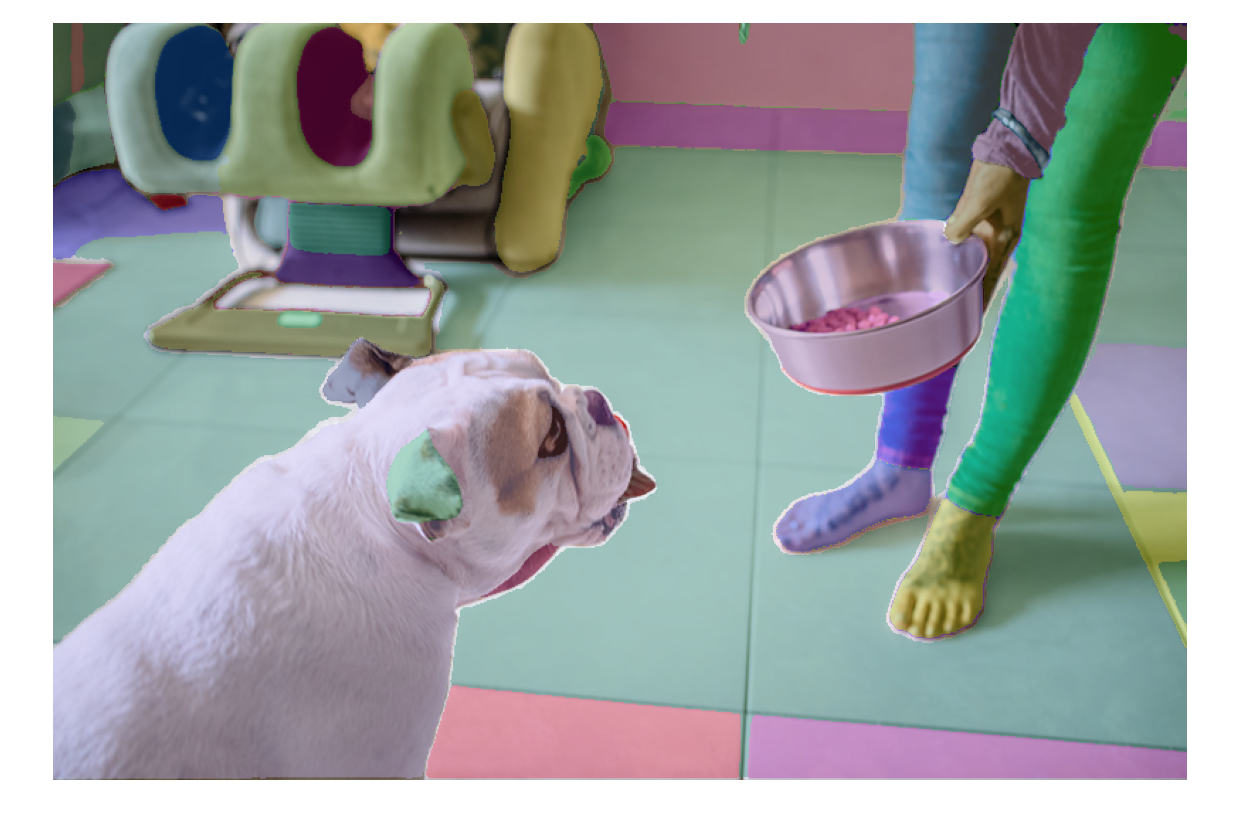
进阶测试
图片预处理部分
其他instruction,都是在这个基础上进行处理
import numpy as np import torch import matplotlib.pyplot as plt import cv2 import sys sys.path.append("..") from segment_anything import sam_model_registry, SamPredictor def show_mask(mask, ax, random_color=False): if random_color: color = np.concatenate([np.random.random(3), np.array([0.6])], axis=0) else: color = np.array([30/255, 144/255, 255/255, 0.6]) h, w = mask.shape[-2:] mask_image = mask.reshape(h, w, 1) * color.reshape(1, 1, -1) ax.imshow(mask_image) def show_points(coords, labels, ax, marker_size=375): pos_points = coords[labels==1] neg_points = coords[labels==0] ax.scatter(pos_points[:, 0], pos_points[:, 1], color='green', marker='*', s=marker_size, edgecolor='white', linewidth=1.25) ax.scatter(neg_points[:, 0], neg_points[:, 1], color='red', marker='*', s=marker_size, edgecolor='white', linewidth=1.25) def show_box(box, ax): x0, y0 = box[0], box[1] w, h = box[2] - box[0], box[3] - box[1] ax.add_patch(plt.Rectangle((x0, y0), w, h, edgecolor='green', facecolor=(0,0,0,0), lw=2)) sam_checkpoint = "./checkpoints/sam_vit_h_4b8939.pth" model_type = "vit_h" device = "cuda" sam = sam_model_registry[model_type](checkpoint=sam_checkpoint) sam.to(device=device) predictor = SamPredictor(sam) img_path = '/data/qinl/code/segment-anything/notebooks/images/truck.jpg' image = cv2.imread(img_path) image = cv2.cvtColor(image, cv2.COLOR_BGR2RGB) # 预处理输入图片 predictor.set_image(image)
- 1
- 2
- 3
- 4
- 5
- 6
- 7
- 8
- 9
- 10
- 11
- 12
- 13
- 14
- 15
- 16
- 17
- 18
- 19
- 20
- 21
- 22
- 23
- 24
- 25
- 26
- 27
- 28
- 29
- 30
- 31
- 32
- 33
- 34
- 35
- 36
- 37
- 38
- 39
- 40
- 41
- 42
- 43
- 44
- 45
- 46
输入的instruction为point的情况
# 输入为point的情况 input_point = np.array([[500, 375]]) input_label = np.array([1]) # 可以用来显示一下点的位置 # plt.figure(figsize=(10,10)) # plt.imshow(image) # show_points(input_point, input_label, plt.gca()) # plt.axis('on') # plt.show() masks, scores, logits = predictor.predict( point_coords=input_point, point_labels=input_label, multimask_output=True, ) print('masks.shape',masks.shape) # (number_of_masks) x H x W # 输出3个mask,分别有不同的score for i, (mask, score) in enumerate(zip(masks, scores)): plt.figure(figsize=(10,10)) plt.imshow(image) show_mask(mask, plt.gca()) show_points(input_point, input_label, plt.gca()) plt.title(f"Mask {i+1}, Score: {score:.3f}", fontsize=18) plt.axis('off') plt.show()
- 1
- 2
- 3
- 4
- 5
- 6
- 7
- 8
- 9
- 10
- 11
- 12
- 13
- 14
- 15
- 16
- 17
- 18
- 19
- 20
- 21
- 22
- 23
- 24
- 25
- 26
- 27
- 28
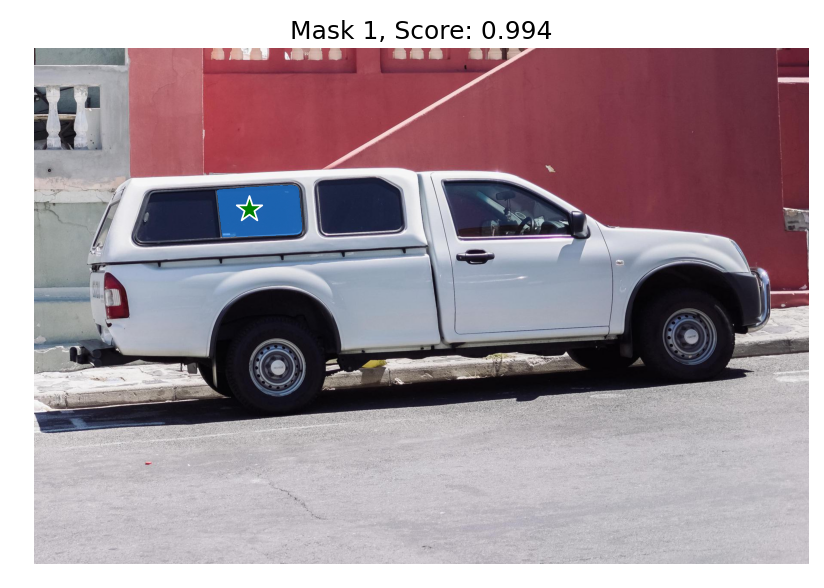
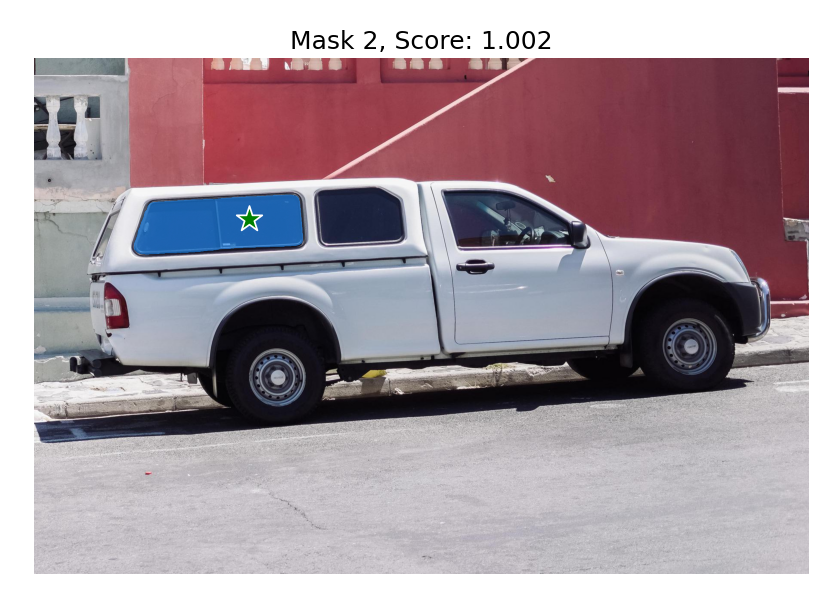
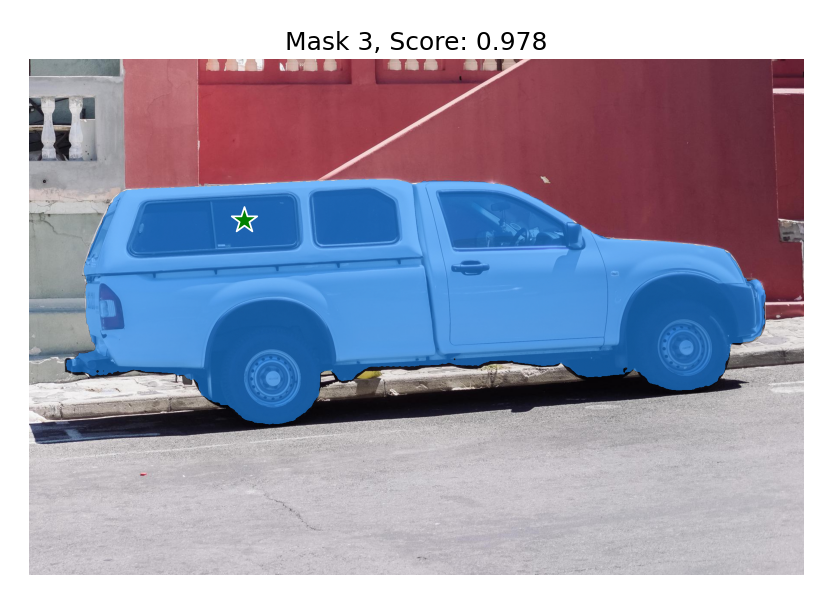
多点输入(都视为前景点)
# 输入为多个point的情况(前景点) input_point = np.array([[500, 375]]) input_label = np.array([1]) masks, scores, logits = predictor.predict( point_coords=input_point, point_labels=input_label, multimask_output=True, ) # additional points input_point = np.array([[500, 375], [1125, 625]]) input_label = np.array([1, 1]) mask_input = logits[np.argmax(scores), :, :] # Choose the model's best mask masks, _, _ = predictor.predict( point_coords=input_point, point_labels=input_label, mask_input=mask_input[None, :, :], multimask_output=False, ) print('masks.shape',masks.shape) # only 1 x H x W plt.figure(figsize=(10,10)) plt.imshow(image) show_mask(masks, plt.gca()) show_points(input_point, input_label, plt.gca()) plt.axis('off') plt.show()
- 1
- 2
- 3
- 4
- 5
- 6
- 7
- 8
- 9
- 10
- 11
- 12
- 13
- 14
- 15
- 16
- 17
- 18
- 19
- 20
- 21
- 22
- 23
- 24
- 25
- 26
- 27
- 28
- 29
- 30
- 31
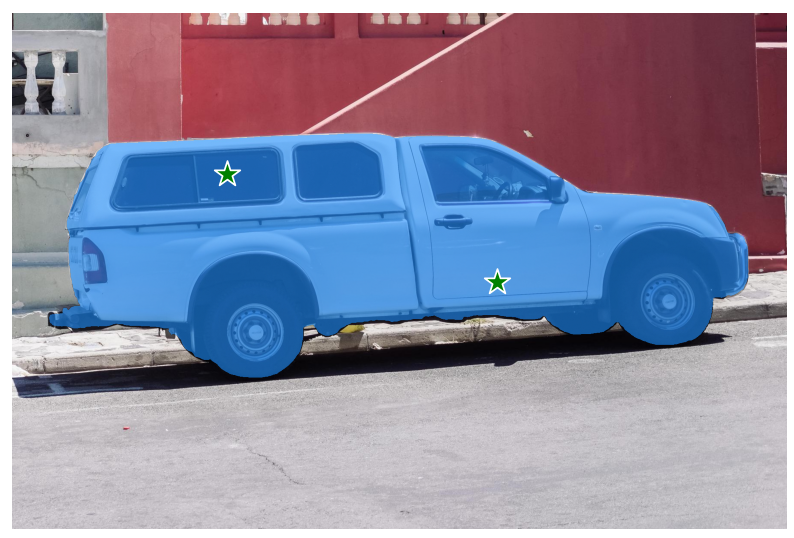
多点输入(前景点加后景点)
决定这个点是前景点还是后景点的就是label,0就是背景的意思
修改标签,得到不一样的结果
# input_point = np.array([[500, 375], [1125, 625]])
# input_label = np.array([1, 1])
input_point = np.array([[500, 375], [1125, 625]])
input_label = np.array([1, 0])
- 1
- 2
- 3
- 4
- 5
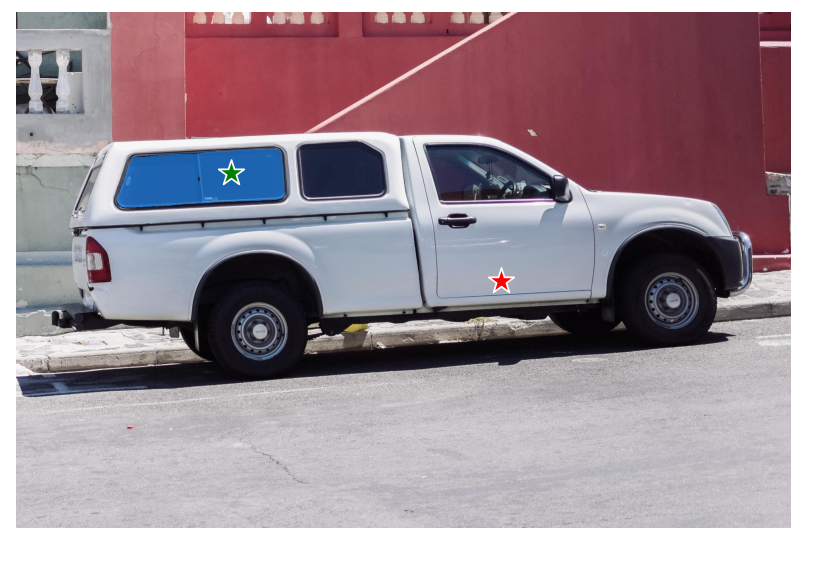
使用box框具体物体
# 输入为additional points
input_box = np.array([425, 600, 700, 875])
masks, _, _ = predictor.predict(
point_coords=None,
point_labels=None,
box=input_box[None, :],
multimask_output=False,
)
plt.figure(figsize=(10, 10))
plt.imshow(image)
show_mask(masks[0], plt.gca())
show_box(input_box, plt.gca())
plt.axis('off')
plt.show()
- 1
- 2
- 3
- 4
- 5
- 6
- 7
- 8
- 9
- 10
- 11
- 12
- 13
- 14
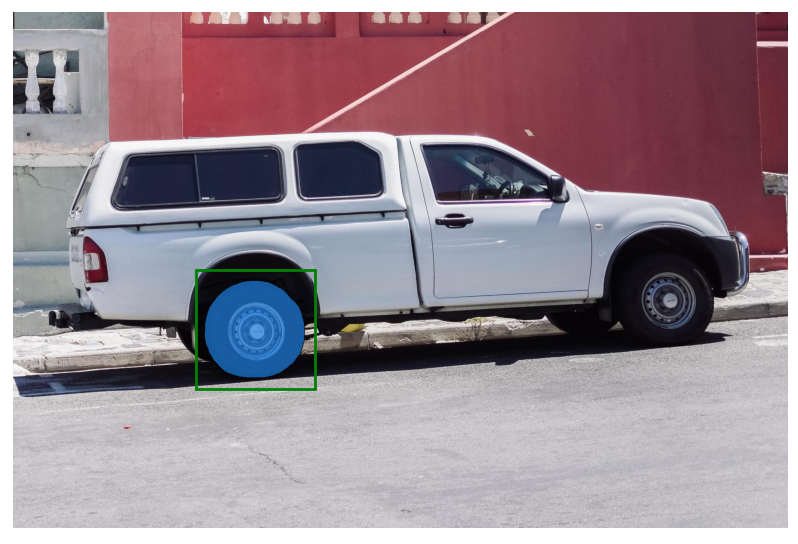
结合points和box
# 输入为point和box input_box = np.array([425, 600, 700, 875]) input_point = np.array([[575, 750]]) input_label = np.array([0]) masks, _, _ = predictor.predict( point_coords=input_point, point_labels=input_label, box=input_box, multimask_output=False, ) plt.figure(figsize=(10, 10)) plt.imshow(image) show_mask(masks[0], plt.gca()) show_box(input_box, plt.gca()) show_points(input_point, input_label, plt.gca()) plt.axis('off') plt.show()
- 1
- 2
- 3
- 4
- 5
- 6
- 7
- 8
- 9
- 10
- 11
- 12
- 13
- 14
- 15
- 16
- 17
- 18
- 19
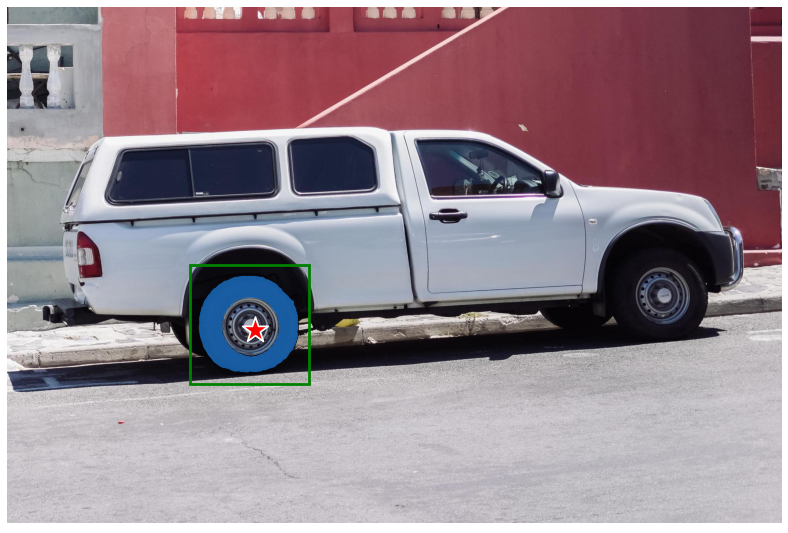
batch prompt inputs
# batch prompt inputs input_boxes = torch.tensor([ [75, 275, 1725, 850], [425, 600, 700, 875], [1375, 550, 1650, 800], [1240, 675, 1400, 750], ], device=predictor.device) transformed_boxes = predictor.transform.apply_boxes_torch(input_boxes, image.shape[:2]) masks, _, _ = predictor.predict_torch( point_coords=None, point_labels=None, boxes=transformed_boxes, multimask_output=False, ) print(masks.shape) # (batch_size) x (num_predicted_masks_per_input) x H x W plt.figure(figsize=(10, 10)) plt.imshow(image) for mask in masks: show_mask(mask.cpu().numpy(), plt.gca(), random_color=True) for box in input_boxes: show_box(box.cpu().numpy(), plt.gca()) plt.axis('off') plt.show()
- 1
- 2
- 3
- 4
- 5
- 6
- 7
- 8
- 9
- 10
- 11
- 12
- 13
- 14
- 15
- 16
- 17
- 18
- 19
- 20
- 21
- 22
- 23
- 24
- 25
- 26
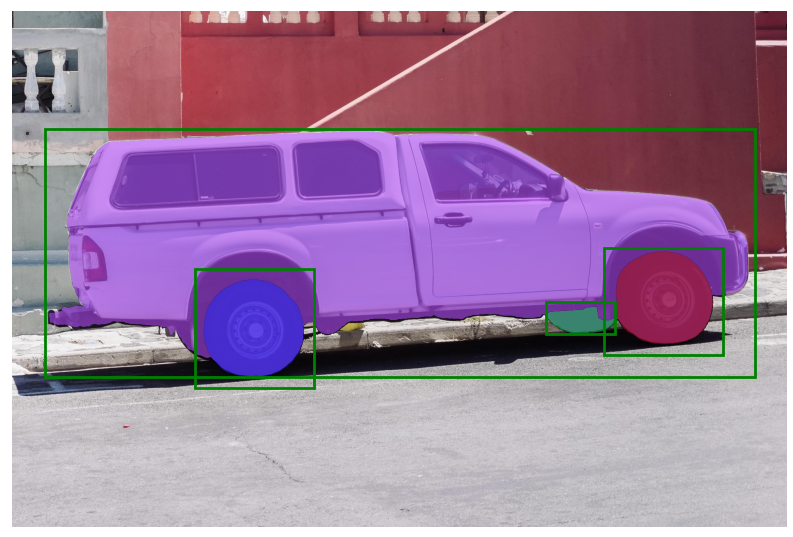
End-to-end batched inference
## End-to-end batched inference image1 = image # truck.jpg from above image1_boxes = torch.tensor([ [75, 275, 1725, 850], [425, 600, 700, 875], [1375, 550, 1650, 800], [1240, 675, 1400, 750], ], device=sam.device) image2 = cv2.imread('./notebooks/images/groceries.jpg') image2 = cv2.cvtColor(image2, cv2.COLOR_BGR2RGB) image2_boxes = torch.tensor([ [450, 170, 520, 350], [350, 190, 450, 350], [500, 170, 580, 350], [580, 170, 640, 350], ], device=sam.device) # Both images and prompts are input as PyTorch tensors that are already transformed to the correct frame. # Inputs are packaged as a list over images, which each element is a dict that takes the following keys: # * `image`: The input image as a PyTorch tensor in CHW format. # * `original_size`: The size of the image before transforming for input to SAM, in (H, W) format. # * `point_coords`: Batched coordinates of point prompts. # * `point_labels`: Batched labels of point prompts. # * `boxes`: Batched input boxes. # * `mask_inputs`: Batched input masks. from segment_anything.utils.transforms import ResizeLongestSide resize_transform = ResizeLongestSide(sam.image_encoder.img_size) def prepare_image(image, transform, device): image = transform.apply_image(image) image = torch.as_tensor(image, device=device.device) return image.permute(2, 0, 1).contiguous() batched_input = [ { 'image': prepare_image(image1, resize_transform, sam), 'boxes': resize_transform.apply_boxes_torch(image1_boxes, image1.shape[:2]), 'original_size': image1.shape[:2] }, { 'image': prepare_image(image2, resize_transform, sam), 'boxes': resize_transform.apply_boxes_torch(image2_boxes, image2.shape[:2]), 'original_size': image2.shape[:2] } ] batched_output = sam(batched_input, multimask_output=False) # The output is a list over results for each input image, where list elements are dictionaries with the following keys: # * `masks`: A batched torch tensor of predicted binary masks, the size of the original image. # * `iou_predictions`: The model's prediction of the quality for each mask. # * `low_res_logits`: Low res logits for each mask, which can be passed back to the model as mask input on a later iteration. print('batched_output[0].keys()',batched_output[0].keys()) fig, ax = plt.subplots(1, 2, figsize=(20, 20)) ax[0].imshow(image1) for mask in batched_output[0]['masks']: show_mask(mask.cpu().numpy(), ax[0], random_color=True) for box in image1_boxes: show_box(box.cpu().numpy(), ax[0]) ax[0].axis('off') ax[1].imshow(image2) for mask in batched_output[1]['masks']: show_mask(mask.cpu().numpy(), ax[1], random_color=True) for box in image2_boxes: show_box(box.cpu().numpy(), ax[1]) ax[1].axis('off') plt.tight_layout() plt.show()
- 1
- 2
- 3
- 4
- 5
- 6
- 7
- 8
- 9
- 10
- 11
- 12
- 13
- 14
- 15
- 16
- 17
- 18
- 19
- 20
- 21
- 22
- 23
- 24
- 25
- 26
- 27
- 28
- 29
- 30
- 31
- 32
- 33
- 34
- 35
- 36
- 37
- 38
- 39
- 40
- 41
- 42
- 43
- 44
- 45
- 46
- 47
- 48
- 49
- 50
- 51
- 52
- 53
- 54
- 55
- 56
- 57
- 58
- 59
- 60
- 61
- 62
- 63
- 64
- 65
- 66
- 67
- 68
- 69
- 70
- 71
- 72
- 73
- 74
- 75
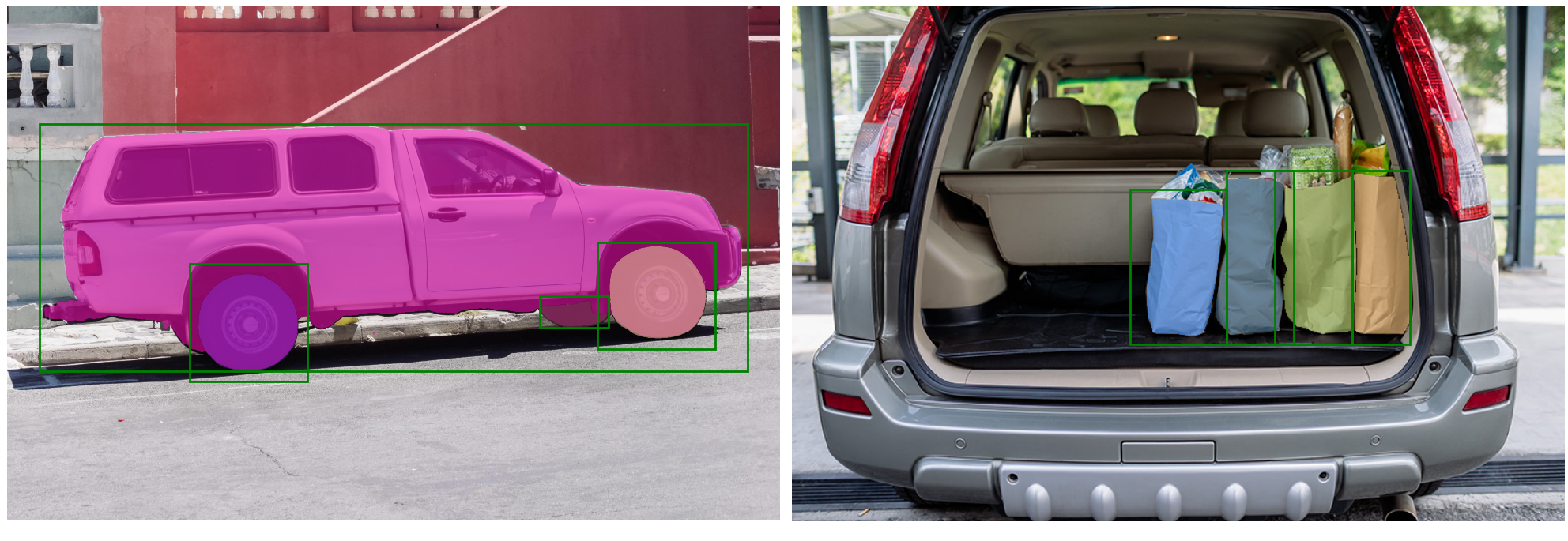
高阶测试
模型训练(waiting)
https://github.com/bnsreenu/python_for_microscopists/blob/master/331_fine_tune_SAM_mito.ipynb



